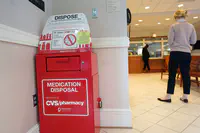Prevention Does not Work Without Treatment, the Story of Prescription Drug Monitoring Programs
The story of PDMPs is a good story of how prevention works, but only when it is dovetailed with qualified residential drug and alcohol addiction treatment centers.

Prescription drug monitoring programs (PDMPs) are a state-level intervention that enables physicians to compare the patient data in front of them with a statewide database. The database will alert physicians if a particular “patient” is an addict who is doctor-shopping for addictive, mind-altering pharmaceutical drugs like opioid painkillers.
The downside of PDMPs is that when addicts are turned away from a physician due to a red flag alert from a PDMP, the addict will almost certainly seek drugs elsewhere if not presented with an accessible drug rehab option. Such addicts often turn to street drugs and potentially lethal fentanyl when they cannot get prescription drugs.
That is why policymakers and public health officials must pair preventive efforts like PDMPs with accessible, residential treatment options for those addicted.
What are PDMPs?
The Centers for Disease Control and Prevention defines prescription drug monitoring programs as: “A prescription drug monitoring program (PDMP) is an electronic database that tracks controlled substance prescriptions in a state. PDMPs can provide health authorities timely information about prescribing and patient behaviors that contribute to the epidemic and facilitate a nimble and targeted response.” Such programs, mandatory in many states, enable prescribing physicians to examine patients’ prescription histories. If a patient has gotten the same drug from other doctors in the past, the PDMP will alert the current doctor as such.1
When the American opioid epidemic began in the early 2000s, it started with the widespread misuse of pharmaceutical opioid pain relievers. These drugs were being prescribed at shockingly high rates across America under the pretense and promise from manufacturers that they were not addictive. Unfortunately, such opioid painkillers were soon causing millions of Americans to become addicted to them, leading to hundreds of thousands of overdose deaths. One of the resulting phenomena from this crisis was a nationwide spike in doctor shopping, a practice that involves individuals seeking prescriptions for the same drug from multiple doctors.
Research Shows PDMPs are Not on Their Own a Solution to the Opioid Epidemic

PDMPs have worked to inform providers that the “patient” they are seeing might be an addict attempting to doctor-shop. But an unintended and often lethal consequence of PDMPs is that addicts prevented from getting prescription opioids through a doctor will often take to the streets and look for illicit synthetic opioids, counterfeit pills, fentanyl, or heroin.2
Researchers at the Naveen Jindal School of Management found that, in states that mandated the use of PDMPs, opioid prescriptions did fall in the years after PDMPs were implemented. Unfortunately, this drove existing opioid users to seek dangerous, illegal substances like heroin, illicit fentanyl, and synthetic street opioids. Quoting assistant professor of marketing Dr. Tongil Kim, “Past research has shown that when facing restricted access to addictive substances, individuals simply seek out alternatives rather than limiting consumption. Therefore, it is critical to assess whether any curb on the supply of prescription opioids leads to an overall reduction in opioid consumption or whether patients simply seek out illicit alternatives, such as heroin. In our case, we measured overdose deaths as a proxy and found a substantial increase, suggesting that the policy unintentionally spurred greater substitution.”3
While Kim contends that the overprescribing of prescription opioids had been one of the primary drivers of the addiction epidemic, Kim also insisted that intervention programs that seek to halt excessive or erroneous prescribing (like PDMPs) must be immediately followed by efforts to treat those addicted to opioids.
Kim’s study focused on 19 states, examining the use of PDMPs within those states and opioid overdose fatality rates in each state. The study found that implementing PDMPs in each of the 19 states led to an average drop in opioid prescriptions by 6.1%. Unfortunately, the implementation was also followed by an uptick in overdose deaths, with heroin overdoses alone spiking 50.1% after states implemented PDMPs.
Further, the researchers also found that keyword searches on Google for “opioid pain relievers” dropped in states that implemented PDMPs, but searches for “heroin” increased significantly. Further, the states with the strictest PDMP implementation approach experienced the most significant drop in prescribing and the highest spike in heroin overdose deaths.
Why Treatment Is a Must

One of the last revelations of the study was that the counties where treatment programs for opioid addiction were readily available did not experience an alarming surge in heroin overdoses after PDMPs were implemented.
The findings seem clear enough. PDMPs were effective in curbing doctor shopping and the overprescribing of addictive opioid pain relievers. Unfortunately, heroin overdoses spiked in states that implemented PDMPs, because addicts who could not get opioids from doctors turned to drug dealers and got hooked on heroin instead. However, counties with accessible addiction treatment services did not experience spikes in heroin overdoses after PDMPs were implemented.
PDMPs are an effective intervention, a preventive tool that puts a degree of oversight on doctors and enables them to be more cautious, conservative, and measured in how they prescribe opioids and who they prescribe them to. But without coupling PDMPs with increased access to residential drug rehab centers for addicts, addicted individuals will seek drugs elsewhere.
If you know someone addicted to opioids, please don’t rely on local PDMPs and doctors to stop your loved one from accessing mind-altering drugs. Make sure your loved one gets real help at a qualified drug and alcohol rehab center as soon as possible. Please don’t wait until it is too late.
Source:
-
CDC. “PDMPS: What States Need to Know.” Centers for Disease Control and Prevention, 2022. cdc.gov ↩︎
-
Wiley. “Electronic prescription monitoring and the opioid epidemic.” Production and Operations Management, 2022. onlinelibrary.wiley.com ↩︎
-
ScienceDaily. “Study: Has prescription monitoring curbed the opioid epidemic?” Science Daily, 2022. sciencedaily.com ↩︎







 ®
®